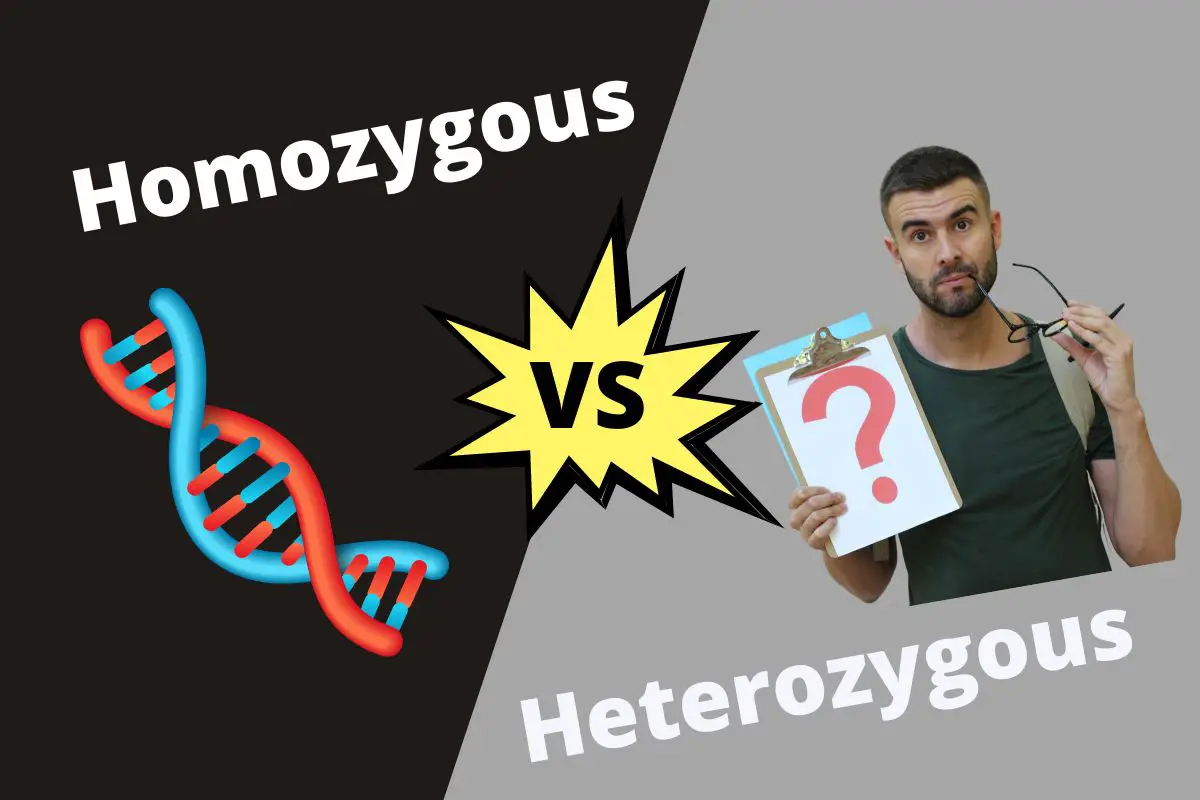A cell is identified as homozygous when it carries two identical alleles in both chromosomes and homologous. And a cell is called heterozygous when it carries two different alleles of a gene.
Homozygous and heterozygous are two terms that identify whether a living being carries two different alleles or similar ones.
Table of Contents
Homozygous vs Heterozygous
| Homozygous | vs | Heterozygous |
| Offspring receives two copies of the same allele leading to a particular trait. For example, you have two copies of the allele of blond hair. | Definition | Offspring receives two different copies of the allele leading to a particular trait. For example, you have one allele of blond hair and one allele of black hair. |
| Results in the repetition of the same traits over generations | Final Result | Results in different traits over generations |
| Homozygous recessive or homozygous dominant For example- either RR or rr | Type of Alleles | Heterozygous genotypes carry different alleles so that they can have both the dominant and recessive alleles—for example, Rr. |
| Can either be homozygous recessive or homozygous dominant | Nature of Alleles | Can show complete dominance, codominance, or incomplete dominance |
| The condition produces only one type of gamete | Gamete | This condition produces two types of gamete |
| Organisms developed under homozygous conditions are called homozygotes | Reproduction | Organisms developed under heterozygous conditions are called heterozygotes |
| Primarily the results of asexual reproduction | Nature of reproduction | Mainly the results of sexual reproduction |
What is a Gene?
A gene is a physical unit of heredity made up of DNA that we acquire from our parents. Each living being inherits two types of genetics- one from each parent. Most people have the same gene with a minimal number of genes that are different in all people.
Alleles are the number of minor genes that are different in all people, bringing in each individual’s unique physical features.
What is a Genotype?
A genotype is the number of gene variants present in the genome at a given location (locus). We can represent genotype also by the DNA sequence in the specific areas. Some genotypes also contribute to specific individual trains, which are called phenotypes.
What Does Homozygous Mean?
Homozygous are cells that have identical alleles. It’s a genetic condition where an individual inherits the same DNA sequence from his/her biological parents.
For instance, one parent has blonde hair, and one has black hair. If a child gets two copies of the black hair gene, they are called homozygous.
These examples go beyond hair. Homozygous refers to cells that have two identical alleles for a particular gene at corresponding positions on homologous chromosomes.
Understanding Genes
Genes are made up of DNA, and these determine the characteristics of organisms like- eye color, hair color, leaf shape, etc.
Chromosomes carry genes in linear order, and alleles are the different forms of the same gene. So homozygous genotypes have the same allele at the same chromosome point for the same gene.
Homozygous is often used in the context of disease. For instance, we get genes from our parents in pairs. One copy of each gene or allele from each parent. If our parents pass down the same allele, that condition is called homozygous.
Being homozygous is rare, so it’s recognized as a unique trait whenever such conditions occur.
What Does Homozygote Mean?
Homozygote refers to organisms that carry the two copies of the same allele for a specific trait and are sure to pass it on to their offspring. In simple terms, the offspring of homozygous genes is called a homozygote.
Animal breeders and gardeners adopt this method of breeding when they want to pass on a specific trait to the litter.
What Does Heterozygous Mean?
A heterozygous genotype is a condition where the cell contains two different alleles from a particular gene at the corresponding position on the homologous chromosome. The process is similar to homozygous, but in this case, it has different alleles from the same gene and at the same point in the chromosome.
Common Examples
For example, a flower bud with a yellow allele and a red allele could result in an orange flower. Depending on how the genes work, the color could be different. But the main point is that the orange offspring has a heterozygous condition as it received both red and yellow copies of the gene.
Heterozygous means that our biological parents pass on their individual pairs of particular genes to us. The hetero genes are passed on in a way that the DNA sequence is slightly different, which leads to our specific traits.
Heterozygous traits could have both dominant alleles and recessive alleles. And how the particular trait develops depends on the nature of the alleles.
What is Heterozygote?
Similar to homozygote, heterozygote is the offspring of heterozygote genes. Heterozygous refers to a specific trait, and no organism can be entirely heterozygous. For instance, a heterozygote progeny will receive different alleles from its parent (Rr).
Homozygous and heterozygous are different conditions of how our biological parents have passed on genes to us. To understand these conditions, you need to remember two easy terms- homo means same and hetero means different.
If you’ve enjoyed this article, check out our post on the difference between osmosis and diffusion.

